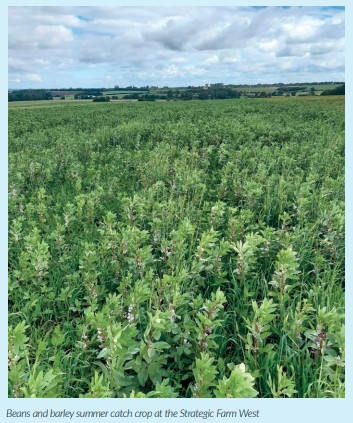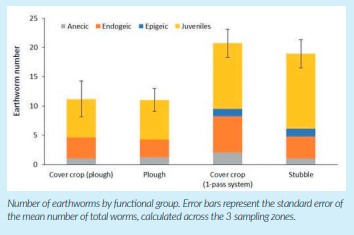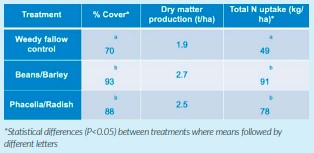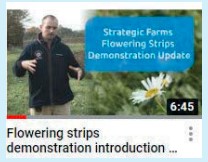Teresa Meadows, AHDB Knowledge Exchange Manager, East Anglia, takes a look through the season and findings from the Strategic Cereal Farm East and West demonstrations for harvest 2020.

As we come into the autumn time, it gives an opportunity to look back on the last harvest – yields, costs, margins and wider improvements to soils or biodiversity achieved over the previous year. Whilst harvest 2020 will be a year to forget in so many ways, there are always lessons that can be learnt along the way. Reflecting on the last season of results from our AHDB Strategic Cereal Farms in the East and the West, this is certainly the case for them too.
The difficult conditions in autumn 2019 and spring 2020 meant that establishing a crop was a real challenge for Rob Fox, Strategic Farm West host in Warwickshire. With much of the OSR area needing to be re-drilled and wheat not able to be drilled at all, alternative solutions were sought to take advantage of the situation. This included the establishment of a summer catch crop area to look at the advantage of having cover in place vs the stubble for the following crop establishment, nutrient uptake and more.
Over in the East, Brian Barker, the farm host in Suffolk had patchy establishment in some areas, challenges to spray off cover crops with enough time to drill the following crop and making decisions on what to do with the opportunity to lower inputs in what resulted in a largely low disease pressure year.

The results from the findings of these trials and demonstrations and other longer running demonstrations on-farm, can be found summarised below. Full details including the reports, graphs and costs are available to download from the links at: https://ahdb.org.uk/sfweekwinter-2020.
STRATEGIC CEREAL FARM EAST
How to manage lowering fungicide, trace element and biostimulant inputs and harnessing varietal resistance
This trial has been looking at how to use varietal resistance as a way of reducing fungicide inputs. Five varieties were assessed (Siskin, Crispin, Santiago, Graham and Shabras) and four programmes of increasing cost were overlaid (untreated, low, medium and high). As harvest 2020 was a low disease pressure season, the results showed that growing more resistant varieties with a low input regime gave the best net margin in this year.
There was a minimal yield response to increasing fungicide spend on the resistant varieties with the low inputs, showing the best net margins. In this year, the highest percentage of septoria was seen on the most susceptible variety, Santiago. The more resistant varieties (i.e. Graham and Siskin) tended to hold onto green leaf area for longer. Varying programmes according to the season, looking at, knowing and harnessing the varietal resistance can certainly work in this kind of season.
Boosting early crop biomass
This demonstration has been looking at whether using a starter fertiliser, either placed or broadcast, is effective at boosting biomass in the autumn. Establishing crops later in the autumn, due to black-grass and BYDV pressure is balanced with the knowledge that crops that yield well have good biomass from the autumn. This demonstration was looking at if it was possible to boost this further with later-drilled autumn crops. The results from this year showed that there may be yield benefits from broadcasting kieserite and possibly TSP at planting where soil nutrient indices are low. However, established plant populations in both fields were fairly low and crop development was slow over winter, due to the season.
On one of the fields, broadcast kieserite and TSP appeared to increase yield by up to 0.4t\ha, whilst polysulphate showed no yield benefit compared to standard farm practice. The results from this work haven’t drawn large conclusions in terms of final yield results, but will be something to bear in mind as we go forward about using this option at drilling.
Cover crops and water quality
Cover crops are well known to have a positive effect on water quality and soil structure. The results from this trial have reinforced those conclusions, demonstrating that a well-established cover crop is effective at improving water quality by bringing nitrate concentrations in drainage water below 50 mg/l. Four different methods have been looked at this year, the second site that we have used the same principles – an area that was ploughed; an area that was ploughed and then a cover crop (rye, buckwheat, phacelia, oil radish, sunflowers) established; an area that was overwinter stubble and then an area of over-winter stubble with a cover crop drilled using a strip till drill at 33cm row spacings.
Soil structural assessments (completed on 14.02.20) using Visual Evaluation of Soil Structure (VESS) scores also indicated that the soil on the ploughed field, Appletree, was classed as being ‘firm’ with some angular non-porous aggregates (i.e. clods) present; whereas in the one-pass system on Blacksmiths, the soil structure was better (i.e. friable/intact) containing more porous aggregates and no clods. Bulk density within the cover crop-ploughed area was marginally higher at 1.57 g/cm3 compared to no cover crop-plough suggesting the soil was more compact which could have impeded root growth.
A good number of earthworms were also recorded across both of the trial fields (i.e. more than 8 per pit), mainly comprising juvenile and adult endogeic (topsoil) earthworms. Overall number of earthworms were greater on Blacksmiths, which was cultivated using a strip-tillage one-pass system (mean = 20) compared to Appletree which was ploughed (mean = 11), with no difference between areas with or without cover crops. Epigeic, (i.e. surface/ litter dwelling) earthworms were recorded on Blacksmiths but not Appletree fields; this corresponded to there being more surface trash following the one-pass system, compared to ploughed. The overall greater number of earthworms and presence of epigeic earthworms on Blacksmiths compared to Appletree, indicates that ploughing maybe having a detrimental impact on both overall earthworm numbers and community structure by reducing the availability of surface trash and disturbing burrows.

On both fields, the mean yield measured within the cover crop area was c.1.7 – 2 t/ha lower (95% confidence interval = ± 0.24 t/ha) than the ploughed treatment at 8.1 – 8.3 t/ha. Drilling the cover crop after autumn ploughing, caused some surface soil compaction and Brian Barker noted that it was harder to drill the spring crop; the slots did not close and pigeons ate the seed. The cover crop area on the one pass system also led to wetter soil conditions at spring crop drilling, with more slug damage. Throughout the season, on the cover crop treatment the spring crop was consistently ‘behind’ compared to the overwinter stubble treatment.

This final result was different to the result from harvest 2019, which showed a positive yield effect after the cover cropped area. This variation in yield (both positive and negative effects) has also been noted in the AHDB MaxiCover Crop research and wider research. It is learning this balance between the original aims for using cover cropping on-farm, which species to use, how to manage their establishment and destruction and release of the nutrients through the following crop that are questions to still be discussed and shared.
Conclusions from this work do continue to show the many benefits of cover cropping to water quality and soils. Furthermore, in the spring if wet soil conditions are likely, allow soils to dry out by leaving a large enough ‘window’ between cover crop destruction and spring crop drilling.
Very low inputs – how low can you go?
A 3.1ha field was also used at the Strategic Farm East this year, where Brian went as low as he felt that he could go with inputs through the season. During the harvest 2020 season, this resulted in a total fungicide spend of £12/ha, a yield of 9.43t/ha and a cost of production of £67/t. Given the low disease pressure season of harvest 2020, these results suggest that there is little benefit in increasing fungicide spend to improve gross margins. Do we have the evidence, in-season monitoring and forecasting and information available to do this at scale going forwards?
STRATEGIC CEREAL FARM WEST
The impact of cultivation depth on soil properties, rooting and yield
The aim of this trial is to determine any differences in soil quality and health, crop rooting properties, yield and cost of production between cultivation systems. Starting in 2018, with three cultivation depths at 5, 15 and 30 cm depths before the addition of direct drilling in 2019, this trial will continue for the duration of the Strategic Cereal Farm West programme. OSR was established in this trial field for harvest 2020 and the results showed the importance of moisture at drilling for OSR. Minimal cultivations and direct drilling can both help to maintain moisture levels for better OSR establishment. Crops that are establishing slowly are at risk from CSFB attack.
As a result, poor plant establishment and fewer plants were found in the deeper cultivation treatments (15 and 30cm) than the shallow cultivation (5 cm) and direct drill treatments. In general, more CSFB adult feeding damage (as % leaf loss area) was found in the treatments with deeper cultivations (15 and 30cm cultivations) than the 5 cm cultivation of direct drill treatment. Additionally, fewer larvae were found on the deeper cultivation treatments (15 and 30cm) compared to the shallow cultivation (5cm) and direct drill treatments, in both November and January (P<0.05).
The average measured yield for harvest 2020 for the 30cm treatment was 2.22 t/ha with yield differences for the treatments showing: 15cm: -0.09 ± 0.51 t/ha 5cm: -0.70 ± 0.50 t/ha Direct drill: -0.53 ± 0.58 t/ha.
The impact of summer catch crops on soil physical properties and performance of the following crop
This demonstration, which started in 2020, is looking at the effect of a summer catch crop on soil nitrogen supply, soil structure and the performance of the following crop in the rotation. In this trial we are comparing the impact of comparing summer catch crop mixes to leaving the land fallow. Three treatments were established in May 2020; a control where the field has been left in stubble, a phacelia and oil radish mix, and farm saved seed and barley. The catch crop was assessed in July 2020 and the results showed:

The topsoil was also noted to be slightly drier where the catch crop treatments had been grown and the soil N supply higher where catch crops were grown. Soil and crop characteristics across these three treatments will now be assessed through to harvest 2022.
So, lots of questions asked, assessments taken place and conclusions that can be drawn across some areas…and always more questions to ask as a result! As with much of what we do in farming, the best place to learn and find what suits your system is to try this out on-farm. The aspiration is that the demonstrations on the Strategic Farms put into practice the findings from the research and then the resources are created for you to be able to take this forward for your farm or business. This can be from counting plants at establishment, disease scoring your crops through the season, looking at earthworm levels or calculating the costs. The links to all of these resources are all available from: h t t p s : // a h d b . org.uk/sfweekwinter-2020.

Many of these results were also discussed through webinars held on these topics, along with wider areas such as weed management and boosting beneficials through the use of flowering strips, through the Strategic Farm Week held on 16-20 November. Recordings of these, along with other videos can be found via the same link above or on the AHDB Cereals and Oilseeds channel on YouTube. As we turn now to harvest 2021, some of the themes of cover cropping, weed management, cultivations, pest and natural enemy assessments are being taken forward, along with new areas of work. We look forward to sharing these results as we go through the season.
As ever if you have questions, comments, suggestions or would like more information, please feel free to get in touch.